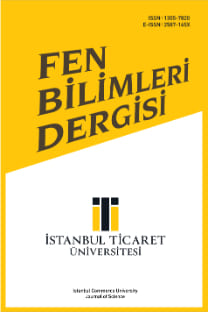İki Düzeyli Olasılık Modellerinde Klasik Meta Sezgisel Optimizasyon Tekniklerinin Performansı Üzerine Bir Çalışma
ol
___
- Agresti, A., (2002). Categorical Data Analysis. 2th edition, New Jersey, John Wiley&Sons Inc.
- Aguilar-Rivera, R., Valenzuela-Rendón, M., Rodríguez-Ortiz, J.J., (2015), “Genetic Algorithms and Darwinian Approaches in Financial Applications: A Survey”, Expert Systems with Applications, 42(21), 7684-7697.
- Altunkaynak, B., Esin, A., (2004), “Doğrusal Olmayan Regresyonda Parametre Tahmini İçin Genetik Algoritma Yöntemi”. Gazi Üniversitesi Fen Bilimleri Dergisi, 17(2), 43-51.
- Babaoğlu, İ., Findik, O., Ülker, E., (2010), “A Comparison of Feature Selection Models Utilizing Binary Particle Swarm Optimization and Genetic Algorithm in Determining Coronary Artery Disease Using Support Vector Machine”, Expert Systems with Applications, 37(4), 3177-3183.
- Goldberg, D.E., (1989). Genetic Algorithms in Search, Optimization and Machine Learning. Addison Wesley, Reading, MA.
- Goldberg D.E., Deb, K., (1991), A Comparative Analysis of Selection Schemes Used in Genetic Algorithms, Foundations of Genetic Algorithms., San Francisco, CA: Morgan Kaufmann.
- Gordini, N., (2014), “A Genetic Algorithm Approach for Smes Bankruptcy Prediction: Empirical Evidence From Italy”, Expert Systems with Applications, 41(14), 6433-6445.
- Hadi, H.S., J.L. Gonzalez-Andujar, (2009), “Comparison of Fitting Weed Seedling Emergence Models With Nonlinear Regression and Genetic Algorithm”, Computers and Electronics in Agriculture, 65(1), 19-25.
- Hadji, S., Gaubert, J.P., Krim, F., (2015). “Theoretical and Experimental Analysis of Genetic Algorithms Based MPPT for PV Systems”, Energy Procedia, 74, 772-787.
- Holland, J.H., (1975). Adaptation in Natural and Artificial Systems. USA, University of Michigan Press.
- Holland, J.H., (1992). Adaptation in Natural and Artificial Systems. 2th edition, Cambridge, London., The MIT Press.
- Karr, C.L., Freeman, M. L., (1999). Industrial Applications of Genetic Algorithms., USA, CRC Press.
- Koh, Y., Yap, C.W., Li, S.C., (2008). “A Quantitative Approach of Using Genetic Algorithm in Designing A Probability Scoring System of an Adverse Drug Reaction Assessment System”, International Journal of Medical Informatics, 77(6), 421-430.
- Johnson, P., Graham, P., Wilson, P., Macaulay, L., Maruff, P., Savage, G., Ellis, K., Martins, R., Rowe, C., Masters, C.,
- Ames, D., Zhang, P., (2013), “Genetic Algorithm with Logistic Regression for Alzheimer's Disease Diagnosis and Prognosis”, Alzheimer's & Dementia, 9(4), P455-P456.
- Lee, K.H., Kim, K.W., (2015), “Performance Comparison of Particle Swarm Optimization and Genetic Algorithm for Inverse Surface Radiation Problem”, International Journal of Heat and Mass Transfer, 88, 330-337.
- Liu, H.H., Ong, C.S., (2008), “Variable Selection in Clustering for Marketing Segmentation Using Genetic Algorithms”, Expert Systems with Applications, 34(1), 502-510.
- Menard, S., (2002). Applied Logistic Regression Analysis, 2th Edition, USA, Sage Publications.
- Meng, Q., Weng, J., (2011), “A Genetic Algorithm Approach to Assessing Work Zone Casualty Risk”. Safety Science, 49, 1283-1288.
- Mitchell, M., (1999). An Introduction to Genetic Algorithms, 5th Edition, Cambridge, London, The Mit Press.
- Pasia, J., Hermosilla, A., Ombao, H., (2005), “A Useful Tool for Statistical Estimation: Genetic Algorithm”, Journal of Statistical Computation and Simulation, 75(4), 237-251.
- Pfeifer, J., Barker, K., Ramirez-Marquez, J.E., Morshedlou, N., (2015), “Quantifying the Risk of Project Delays with a Genetic Algorithm”, International Journal of Production Economics, 170(A), 34-44.
- Reeves, C.R., Rowe, J.E., (2002). Genetic Algorithms Principles and Perspectives. A Guide to GA Theory., USA., Kluwer Academic Press.
- Rechenberg, I., (1973), Evolutions Strategie–Optimierungtechnischersystemenach Prinzipien Der Biologischen Evolution. (PhD.Thesis). Fromman-Holzboog, Germany.
- Stylianou, N., Akbarov, A., Kontopantelis, E., Buchan, I., W. Dunn, K., (2015), “Mortality Risk Prediction in Burn Injury: Comparison of Logistic Regression with Machine Learning Approaches”, Burns, 41(5), 925-934.
- Yuan, F.C., Lee, C.H., (2015), “Using Least Square Support Vector Regression with Genetic Algorithm to Forecast Beta Systematic Risk”, Journal of Computational Science, 11, 26-33.
- ISSN: 1305-7820
- Yayın Aralığı: 2
- Başlangıç: 2002
- Yayıncı: Doç. Dr. Necip Şimşek
KISMİ SIRALI Gp-METRİK UZAYLARDA DARALMA DÖNÜŞÜMLERİ İÇİN BAZI ORTAK SABİT NOKTA SONUÇLARI
BANKACILIK SEKTÖRÜNDE VERİ ZARFLAMA ANALİZİ İLE ETKİNLİK DEĞERLENDİRMESİ LİTERATÜR TARAMASI
Seda KURŞUN, Ali Osman KUSAKCİ
Kısmi Sıralı Gp Metrik Uzaylarda Daralma Dönüşümleri İçin Bazı Ortak Sabit Nokta Sonuçları
Bankacılık Sektöründe Veri Zarflama Analizi İle Etkinlik Değerlendirmesi Literatür Taraması
Seda KURŞUN, Ali Osman KUŞAKÇI
GEÇMİŞTEN GÜNÜMÜZE MONTAJI KULLANICI TARAFINDAN YAPILAN MOBİLYALARIN SEKTÖRDEKİ YERİ
Berna KAYACAN, Yaprak ÖZEL, Yavuz IRMAK
MOBİL CİHAZLARDA GÜVENLİK – TEHDİTLER ve TEMEL STRATEJİLER
Gözde KARATAŞ, Akhan AKBULUT, Abdül Halim ZAİM
Hammadde Renk Tabanlı Çizelgeleme Ve Bir Elektronik Fabrikasında Uygulaması
Mobil Cihazlarda Güvenlik Tehditler Temel Stratejiler
